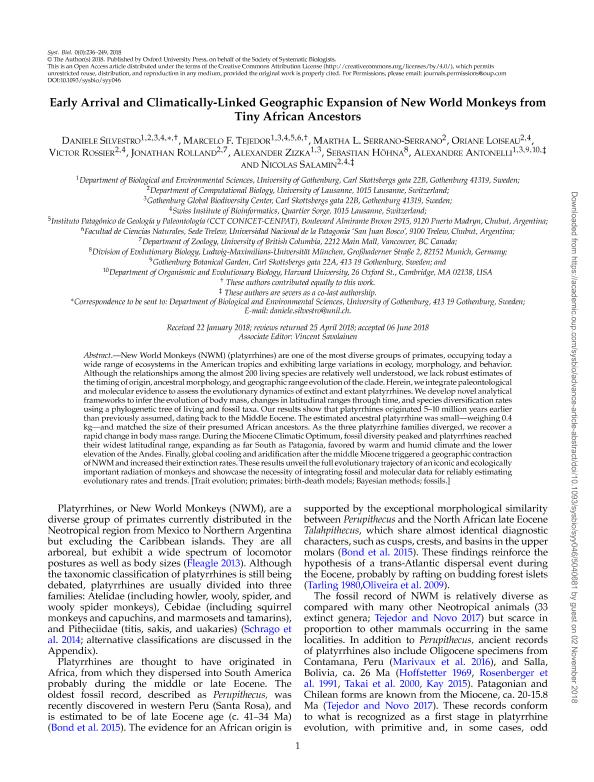Artículo
Early Arrival and Climatically-Linked Geographic Expansion of New World Monkeys from Tiny African Ancestors
Silvestro, Daniele; Tejedor, Marcelo Fabian ; Serrano Serrano, Martha L.; Loiseau, Oriane; Rossier, Victor; Rolland, Jonathan; Zizka, Alexander; Höhna, Sebastian; Antonelli, Alexandre; Salamin, Nicolas
; Serrano Serrano, Martha L.; Loiseau, Oriane; Rossier, Victor; Rolland, Jonathan; Zizka, Alexander; Höhna, Sebastian; Antonelli, Alexandre; Salamin, Nicolas
 ; Serrano Serrano, Martha L.; Loiseau, Oriane; Rossier, Victor; Rolland, Jonathan; Zizka, Alexander; Höhna, Sebastian; Antonelli, Alexandre; Salamin, Nicolas
; Serrano Serrano, Martha L.; Loiseau, Oriane; Rossier, Victor; Rolland, Jonathan; Zizka, Alexander; Höhna, Sebastian; Antonelli, Alexandre; Salamin, Nicolas
Fecha de publicación:
01/2019
Editorial:
Oxford University Press
Revista:
Systematic Biology
ISSN:
1063-5157
e-ISSN:
1076-836X
Idioma:
Inglés
Tipo de recurso:
Artículo publicado
Clasificación temática:
Resumen
New World Monkeys (NWM) (platyrrhines) are one of the most diverse groups of primates, occupying today a wide range of ecosystems in the American tropics and exhibiting large variations in ecology, morphology, and behavior. Although the relationships among the almost 200 living species are relatively well understood, we lack robust estimates of the timing of origin, ancestral morphology, and geographic range evolution of the clade. Herein, we integrate paleontological and molecular evidence to assess the evolutionary dynamics of extinct and extant platyrrhines. We develop novel analytical frameworks to infer the evolution of body mass, changes in latitudinal ranges through time, and species diversification rates using a phylogenetic tree of living and fossil taxa. Our results show that platyrrhines originated 5-10 million years earlier than previously assumed, dating back to the Middle Eocene. The estimated ancestral platyrrhine was small-weighing 0.4 kg-and matched the size of their presumed African ancestors. As the three platyrrhine families diverged, we recover a rapid change in body mass range. During the Miocene Climatic Optimum, fossil diversity peaked and platyrrhines reached their widest latitudinal range, expanding as far South as Patagonia, favored by warm and humid climate and the lower elevation of the Andes. Finally, global cooling and aridification after the middle Miocene triggered a geographic contraction of NWM and increased their extinction rates. These results unveil the full evolutionary trajectory of an iconic and ecologically important radiation of monkeys and showcase the necessity of integrating fossil and molecular data for reliably estimating evolutionary rates and trends.
Palabras clave:
BAYESIAN METHODS
,
BIRTH-DEATH MODELS
,
FOSSILS
,
PRIMATES
,
TRAIT EVOLUTION
Archivos asociados
Licencia
Identificadores
Colecciones
Articulos(IPGP)
Articulos de INSTITUTO PATAGONICO DE GEOLOGIA Y PALEONTOLOGIA
Articulos de INSTITUTO PATAGONICO DE GEOLOGIA Y PALEONTOLOGIA
Citación
Silvestro, Daniele; Tejedor, Marcelo Fabian; Serrano Serrano, Martha L.; Loiseau, Oriane; Rossier, Victor; et al.; Early Arrival and Climatically-Linked Geographic Expansion of New World Monkeys from Tiny African Ancestors; Oxford University Press; Systematic Biology; 68; 1; 1-2019; 78-92
Compartir
Altmétricas



